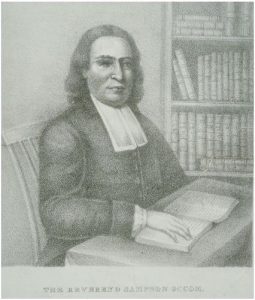Introduction to Samson Occom by Elizabeth Johnson
Samson Occom (1723-1792)
by Elizabeth Johnson
Samson Occom was a Mohegan member of the northernmost branch of the Pequot tribe. He is perhaps best known for being instrumental in the very beginning foundation of Dartmouth University in Hanover, New Hampshire. He developed his own unique style of teaching native American pupils of the time, incorporating Christian values and practices in to lessons of the day.

Samson Occom was born in New London, Connecticut in 1723. At the age of sixteen, Samson heard sermons and teachings of some of the English Christian ministers in the area. He quickly became interested in learning how to read and write, as well as learning more about the Christian faith, which he quickly embraced and converted to.
Occom was so given to this new faith. He longed to master the art of reading, so that he could read the Bible more effectively, and also possessed a great desire to instruct his uneducated brethren in their letters. At age 19, Occom asked his mother to petition Reverend Eleazer Wheelock to instruct Samson in his reading and writing. Mr. Wheelock enthusiastically took on his new pupil. He at once sent for Samson, who stayed with Wheelock for a period of four years, rather than a few days, which he hadoriginally anticipated.
During this four years, Reverend Wheelock took Samson fully under his wing, accepting donations of clothing and money for his poor Indian student. After this time, Wheelock also received a recurring stipend from the Honorable Commissioners at Boston. In the last year of these four, Samson grew very weak, and could hardly see to read. He was unable to effectively study his books, and quit his studies with Wheelock.
Occom searched for work as a School Master, and eventually settled in Montauk, Long Island, answering an increased demand for Indian educators in the area. His first order of business in the daily classroom procedure was to lead his pupils in prayer. He would arrange their seating so that the more learned, brighter students would be seated close to those whom had more trouble in their studies. This allowed the students to learn from one another, as well as from their instructor. In an occurrence that a student wished to leave the classroom, he or she was obliged to spell out a word they had been working on. When dealing with the more “dull” of the pupils, Occom bade them to select the correct letters from a group of lettered tiles he had fashioned from cedar chips. The student would begin this process, having the chips set in proper alphabetical order, but after a time, Occom would begin to jumble the chips together, so that the student would need to reassemble them or find the correct letter out of order. Occom saw this to be an effective way to teach those whom perhaps were not as bright as the other students.
Occom accompanied Reverend Nathaniel Whitaker to England in 1765, in an attempt to gather funds for the Indian Charity School, which had been founded by Wheelock. He generated approximately twelve thousand pounds. Occom left his family under the care of Wheelock in his absence, and returned home to find them malnourished and ill. He then discovered the Wheelock intended for the money he raised to be used to move the Indian Charity School to Hanover, New Hampshire. Occom became very angry over these developments, and predicted to Wheelock that a school so affluency-based would not be beneficial to the Indian community. And, proving Occom right, the school (which had then become Dartmouth University) ceased to minister to Indian pupils. Upon this develpoment, Occom and Wheelock cut off their long relationship (Baym ad Levine, 2012).
After his dissociation with Wheelock, Occom became a staunch advocate for Native American rights. He became famous after delivering a poignant sermon at the execution of Moses Paul, a Wampanoag Indian convicted of murder. This sermon pointed out the hypocrisy of the christianity of the white man. Following this sermon, he was invited to speak at various events all along the Eastern coast. Upon meeting many of the tribesmen and witnessing the conditions in these towns, he became more convinced that the Indian people needed to break away from the influences of the Anglo culture. After the Mason Land Case was decided against the Mohegan tribe, and they lost trust of the land which had supposedly been held for them, Occom, along with family members and friends, founded Brothertown, a settlement for Christian native Americans from several tribes. They originally settled in the Oneida country of upstate New York. However, plagued with harassment from corrupt land agents, the settlement was moved to Lake Winnebago. Occom died before he was able to move his family to the new settlement (Dartmouth, 2015).
Occom was a man who highly valued the empowerment of his people through education. He strived throughout his adult life to help achieve prosperity and autonomy for his fellow Indian. He succeeded, in many cases. Unfortunately, the white man consistently let him down. Wheelock used him as a pawn to generate money and neglected Occom’s family when he was entrusted to assure their health and well-being. This was the first in many negative experiences that Occom would have with the white man. These experiences were likely shared by other Indians of the time, and likely led to a widespread, uniform distrust of the white man among the native Americans.
Works Cited
Baym, N., & Levine, R. S. (2012). The Norton anthology of American literature (8th ed., Vol. A). New York: W.W. Norton &. pp. 445-448
“Biography.” Samson Agonistes: Introduction, Dartmouth University, 8 Dec. 2015, www.dartmouth.edu/~occom/occoms-biography/.
Text included with the permission of the author.
Image: Sketch of Samson Occom, Public Domain, Wikimedia Commons.

